| |

Stan in his tent, which would become his home during his entire service in Egypt.
The only home comforts were the photographs he had brought with him,
which included one of his mother and one of his youngest sister, Marion. |
| So there I was, 18 years of age, I didn’t have a driving licence because the starting age for drivers was 18 and only the rich people had cars so I hadn’t yet had the chance. I had done a lot of driving, but only in the quarry’s, I had never driven on the road but had acquired a lot of road sense in the past four years. So with my orders understood, I selected first gear and set off, I only got about 20 yards when he said to me “by the way gunner, we drive on the right in |
| Egypt.” I was out on the road for about 15 minutes, maximum, my first manoeuvre was to turn left, I approached a small roundabout, turned right through Fayid village, did a circuit of the local football stadium and returned back to camp in one piece. The test ended at RHQ, where I had started from. I followed Sergeant Atkins into the office where he handed me a piece of paper and said “sign here”. This was to be my driving licence for the duration of my army service. It read: “This is to certify that Gunner Briggs is allowed to drive goods vehicles of His Majesty’s Forces (King George VI 1949). As I was signing it he informed me that when I left the army they would replace it with a ‘pink slip’ which my local authority would change for a civilian driving licence. I thought I had joined ‘Fred Karno’s Army’ but there was more to come. He handed me an A4 size piece of paper and said “sign here”, this was the paperwork for the lorry that was assigned to me for the rest of my posting in Egypt. The lorry type and number ‘6240037 Austin K5 FWD’ was written on top of the paper. |
|
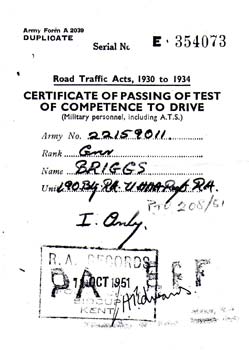
Driving Test Certificate
|
| A list including spare wheel, canopy canvas, canopy frame, jack, jack handle, jerry cans, water and petrol etc., etc., what a farce in 1949, you couldn’t make a story like that up, I still think most people don’t believe me, but actually, it was only then that I really started to learn how to drive. I wasn’t a ‘gunner’ any more; I was enrolled in the MT (Motor Transport) section of the 71st HAA RA, which was a far better job than being a member of a 3.7 gun crew. I had a lot more freedom and was doing an interesting job with a lot of responsibility. |
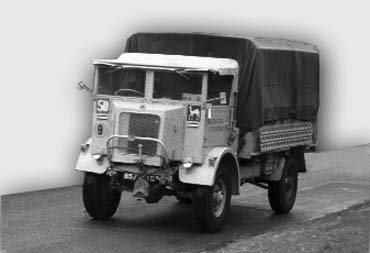
|
|
Schemes
Some of the driving jobs were ‘scheme duties’ which included Gunnery Scheme, Sports Schemes, Cookhouse Schemes, Food and Mobile Ovens and Holiday Schemes for relaxation. On these schemes, I used to take my fold up army bed and four biscuits (straw filled mattresses) and erect it in the back of the truck. It fitted perfectly across the width of the lorry. All the other gunners had to sleep in Bivouac’s after they had dug a hole about a foot deep in the sand. I was supposed to do this too but I never got caught and much preferred it in the back of my lorry! |
| The first scheme I ever went on was a gunnery scheme; I was in the middle of a convoy following the leading vehicle that had an officer in charge. We made our way from Fayid towards Suez on the main road and when we had travelled about twenty miles with the Red Sea on our left, the leading vehicle suddenly turned right into the desert. We all followed and after a few miles I got the shock of my life as we were passing tanks, lorries, guns, half tracks and all sorts of military equipment that had been burnt, blown up and damaged from the
1939-1945 war, which had only ended four years previously. We eventually reached our point on the map in the middle of nowhere and formed a circle, just like the wagon trains in the western films. The driving position is very high on the Austin K5, I opened the door, jumped out onto the sand, looked down and found out that I had landed on top of an old Wilkinson’s Pontefract Cakes empty packet, I picked it up and said |
|
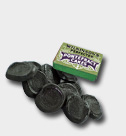
Wilkinsons
Pontefract
Cakes |
|
 Parking up - wagon train fashion !
Parking up - wagon train fashion !
to Sergeant Atkins, “What’s the odds of that?, I’m four thousand miles from Pontefract and look what I’ve found”. It was the old fashioned Pontefract Cakes green packet with the name clearly still on it. He understood what I meant when I told him I lived in Pontefract and he informed me that schemes had been held there on that same site by the 71st HAA for many years. I never did save that packet, but in hind sight, I should have done!
I also used to carry all the sports gear when we had a scheme and had to help mark out the tracks for the running events which were 100 yards, 1 mile and 3 miles, the long jump, high jump, hammer and Javelin events too. I think these events were to break the boredom for the troops. I remember going on a seven day holiday scheme but can’t exactly remember the location, but I do remember that we spent the seven days swimming in a lake and bathing in hot springs. We were all around about 18 years old and fit as ‘a butcher’s dog’.
On other scheme’s I used to carry the cookhouse gear, including all the fruit, food and veg and mobile cooking ovens, so I was guaranteed plenty to eat, especially as one of my mates was Private Elliot, Army Catering Core! He was attached to the 71st HAA as was also a football fanatic from Liverpool. I originally pall’ed up with him when I played a few matches for the regiment.
I enjoyed all these schemes because they kept me fit and alert, some of my mates went on holiday to Cyprus with money sent from home, I believe the cost was about £50 for a fortnight in those days; I had absolutely no chance of obtaining that kind of money from home. |
 |
|
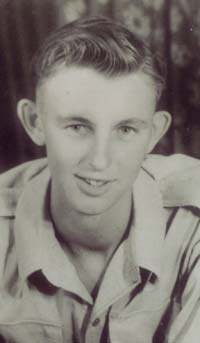 |
|
Sports
A lot of my time was taken up with football, I played a few matches for the Regiment, but found out that it seemed to be on a rota system and they picked you to play in any position on the field.
I settled into the 190 Battery Team and played right full-back with my mate, John Sturmey from Wolverhampton, who idolized Billy Wright, the England and Wolves player. Sturmey was the Peter Crouch of today, very tall, brilliant, on the ball, could head the ball well, wasn't |
GNR Stan Briggs and GNR John Sturmey
( 1949-51 Soldiers, Friends and Sports Team Members ) |
|
afraid to tackle and had a very good football brain. Why he didn’t play professional football after his army service I will never know, he certainly had the ability.
Athletics
I also competed with Sturmey in the 190 Battery Team in the three running athletics events against RHQ, 186 Battery and 187 Battery. He always came first; nobody in Egypt could catch him so we had no chance.
Over the last three years, I have been calling in to pick |
|
2007 - GNR Stan Briggs & GNR John Sturmey |
|
| him up from Wombourne near Wolverhampton on my way to our annual 71st HAA reunions held at Woolwich Barracks, London. We have spent many hours reminiscing of times during our army days and I have thoroughly enjoyed having the opportunity to spend time with him again. We visited other RAF and Army Camps for cross country races in the season, it was through our success on the track that we were both picked for the’ All MELF (Middle East Land Forces) Cross Country Race’, which took place in Fayid at the back of our camp, Normandy, in the winter of 1950. We had to run about three miles in my recollection, climb the Gebel Shabrawit Hill; I don’t think you could call it a mountain but it certainly seemed a long way to the top. On reaching the top you had your hand stamped and then you made your way back down and ran the three or so miles back to the finish. |
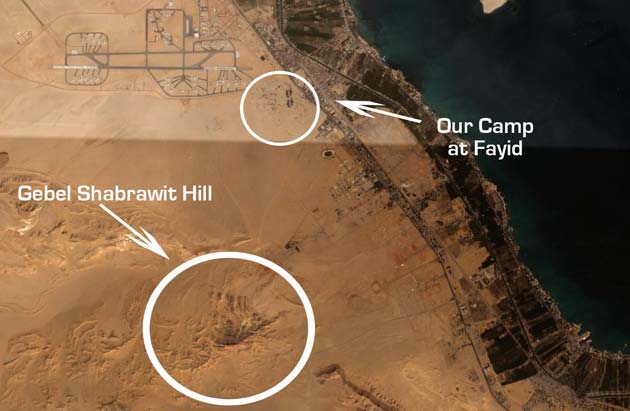 |
The nick name for this hill was ‘The Flea’, don’t ask me why, I don’t know, but I did know that there was several ways to the top. As our camp was so close, we practiced daily to find the best and easiest way to the top. Some of it was hard as rock and some of it was like running in fine sand, one step forward and two steps back. We must have done our homework well and found the best way up because our team ended up winning the cup. I think there were about 200 hundred runners who started. One of our team members, Gunner Wright, came second and I came 51st, when they totted up the overall team points up, the team with the lowest points were the winners (1st place = 1 points, 2nd place = 2 points etc., therefore the lowest points won). So we had won, and what’s more we had managed to win without our best runner, John Sturmey! He had had a fall out with our CO, Lieutenant Colonel Villiers, which meant he wasn’t allowed to run in the race.
I still have the cup I was presented with, the inscription reads:
Gunner Briggs
71st HAA Regiment RA
Winners - Gebel Shabrawit Challenge Cup Cross Country Race
Egypt 1950 |
|
I remember that Major Cleave was our team coach and that another team member from Leeds whose nick name was ‘Yorkie’ of RHQ came in early also. Major Cleave took our winning team out for a meal to celebrate and I also remember that we were given two photographs each, one was a team photo and one was of the race start. Unfortunately, after a few house moves, my photos have been mislaid.
My wife and I recently went to visit Major Cleave at his home in Cornwall, he is actually a very ill man these days but it was wonderful to see him again and he and his wife were very gracious to us and good company. I did ask him about these photos but he was unable to help me with this situation.
Does anyone out there know Gunner Wright? who was in 186 Battery or the blonde postie from RHQ and Leeds who used to deliver the mail singing all the Al Jolson songs of that era? Are you one of the other three members of the team?
If so, I would be grateful if you would contact me and love to hear from you. |
|
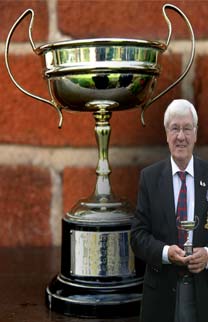 |
Swimming
I remember visiting other army and RAF camps, especially Geneifa, competing in swimming events but I couldn’t keep up with their pace. I was a strong swimmer but didn’t have the speed of the other guys competing! Not one of my better sports!
Cricket
We used to practice cricket on a concrete wicket at the side of the football pitch, but there was no serious thought about playing for the Regiment as 99% of the team was made up of officers, we didn’t get much of a look in. Only one gunner played for the 71st HAA Cricket Team, his name was Bolland from Rotherham and he was a fast bowler.
One day all the drivers were told to report to RHQ, where we were ordered to dismantle our canopy’s and frames and sent to haul soil for the football pitch which was situated between the army and officers quarters. The reason being was that although the pitch was as flat as snooker table, it was dangerously hard. My memories fail me as to exactly where we went to get the soil, but I think it was the Sweet Water Canal. We must have brought scores of loads which we dumped all over the football field. Our next job was to break it up and rake it over. After that, we rolled it in and finished up with a 2 to 3 inch layer of soft soil. Every time we played a match the opposition would congratulate us on having such a good quality playing pitch. |
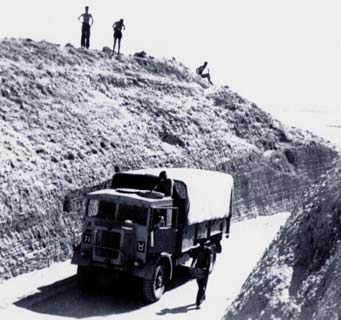 |
|
At that time I was also a ‘Duty Driver’ for a month, conveying our Regiments married families personnel to Ismailia, where they were billeted each night and then brought back to camp the next morning. Major Cooper, our Battery Commander, always sat in the cab with me and was consistently saying to me “put your foot down on the throttle Gunner because I want to get home to my wife as quickly as possible”. In other words, break the speed limit which was a serious offence in the army. One day when I was on my way back to camp with one of the loads of soil previously mentioned, I was driving along at 40MPH when suddenly a Jeep overtook me and then pulled me over. |
The Captain who stopped me for speeding put me on a 252 charge, so the next day at camp it was ‘cap and belt off, double quick march’; I was hauled in front of the presiding officer for judgement! Guess who it was? yes that’s right, Major Cooper! So there I was, on one hand I had a major saying that I was going too slow and on the other, a Captain who said I was going too fast. The Captain said that if another vehicle had been coming the other way and we had collided, it would have been an 80MHP crash! Major Cooper, looking over his half glasses at me, and knowing that he had to carry out some sort of punishment, announced “Briggs, you are not going to get away with this, speeding is very serious offence, therefore, you have a three day CB (confined to barracks), and you can white-wash my office out. The Captain looked on and was furious at the lenient reprimand; he glared at me and then stamped out of the room. I swear if looks could kill I would have been dead on the spot. Unfortunately for the Captain, it ended up for me being a case of ‘one good favour deserves another’ as far as the Major was concerned!
Entertainment & Leisure
We used to go down to Fayid Lido and spend a lot of time swimming there; the area was marked off with pontoons which acted as a swimming pool. The Suez Canal area which runs through Fayid is called the ‘Great Bitter Lake’ and the ‘Small Bitter Lake’ and is a very wide area of canal. The lake, situated half way between Port Side and Suez, serves as a holding point for the ships while the shipping lanes to both sides become clear for them to pass.
When we were on the banks of the lake, we used to count the days when our ship was coming in! The one to take us home!
There were four beaches at the Lido, one for the officers, one for sergeants, one for the other ranks and one for the WRAC (Women’s Royal Army Corps). At one time I did a ‘one month duty’ as a life saver on the Sergeants beach. I had a small dingy and all the life saving gear in a room adjoining the beach bar which meant that all the drinks were free for me, as I remember the duty was from 8am to 6pm. My responsibility was to watch over and protect the Sergeants wives and children.
At the Lido, there was also a roller-skating rink, every now and then and Egyptian group would entertain us on the rink with their usual fire eating, belly dancing routines and acrobatics. The group’s dressing room consisted of six adjoining garages with a corrugated roof, and I remember on one evening that about two dozen locals climbed up onto the roof so that they could get a better view of the show. In the middle of the show, all of a sudden, they all disappeared in a cloud of dust! That ended the entertainment for the evening; we couldn’t stop to see if anyone was injured as we all had to quickly high-tail it back to camp. |
One of the highlights was when the famous ‘Ivy Benson’s All-Girl Swing Band’ toured Egypt, they came and gave us a show in our NAAFI (Navy, Army & Air Force Institutes), they were absolutely brilliant!
We were allowed out of camp when we were ‘off-duty’ and we used to go to the Cameronia Cinema and see the films of the day, we also used to visit Fayid village where all the local shops were selling all sorts of watches and leather goods etc., I still have a wallet I bought there in 1950.
|
|
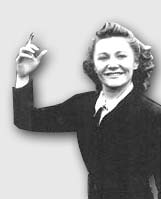 Ivy Benson
Ivy Benson |
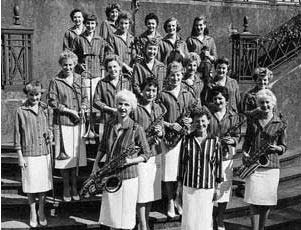
Ivy Benson’s All-Girl Swing Band |
|
One day, three of us were roaming the area when we came across a run-down stadium that it turned out had been built out of concrete by the German prisoners of war from the previous war.
There was a football field in the middle and a running track on the outside. Between the running track and the concrete terracing the German prisoners of war had sculpted statues representing all of the Olympic events. They had also decorated the stadium walls with paintings and mosaic’s. Although it hadn’t had the best of upkeep, it was still marvellous to see and thinking about it, I bet they were glad that they were doing that instead of fighting! |
I have since met many RAF veterans and they have told me they had a large number of German POWs working in their camps, but we never had any in ours. All our workers were Egyptian.
| |
. . . Don't miss 'Part 4' of Stans Stories from the Desert |
|
|
|




